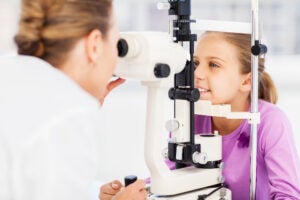What to Expect at a Pediatric Eye Exam

Regular eye exams are crucial for a child’s health and development, as vision significantly affects how children learn and interact with the world. Therefore, you should start scheduling routine eye exams for your child at a very young age. Here’s what to expect during pediatric eye exams as your child grows and develops.
Why Do Children Need Eye Exams?
A child’s eyes aren’t done developing when they’re born. In fact, significant changes occur between birth and six years old. Detecting problems early can prevent potential vision loss and improve your child’s quality of life. Many issues are undetectable without a comprehensive eye exam because young children can’t communicate their symptoms and may be unaware of what “normal” vision looks like.
What to Expect at Your Child’s First Pediatric Eye Exam
The American Optometric Association recommends scheduling your child’s first comprehensive eye exam between six months and one year old. During this exam, the optometrist evaluates your child’s eye health and vision development, checking for any signs of eye diseases, focusing issues, and other visual impairments.
At this stage, optometrists use retinoscopy, or shining a light into the eye, to observe the retina and determine a prescription for kids’ eyeglasses. To assess how well your child’s eyes work together, the eye doctor may use random dot stereopsis, or patterns of dots and 3D glasses. The doctor may also use pediatric eye charts with pictures and shapes rather than letters to test visual acuity.
What to Expect at Pediatric Eye Exams for Two- to Five-Year-Olds
As your child grows and develops, continue scheduling regular eye exams to keep on top of any vision changes. At preschool age, pediatric eye exams include many of the same tests as the first exam, with the addition of a few more.
Eye doctors test visual acuity, depth perception, and color vision in two- to five-year-olds. They may also test for amblyopia, or lazy eye, a condition where one eye’s muscles don’t develop properly, making it weaker than the dominant eye. The optometrist also checks for strabismus, or crossed eyes, along with convergence insufficiency, where the eyes don’t work together when focusing on near objects.
Pediatric Eye Exam Procedure for Older Children
As your child reaches school age, their eye exams become more similar to adult eye exams. The optometrist still evaluates eye health and visual acuity, but they may also assess your child’s eye teaming, tracking, and focusing skills. New specialized equipment may also be introduced at this stage, including a slit-lamp microscope to magnify the eye’s structures and an autorefractor to measure the eye’s focusing ability.
Pediatric Eye Exams in Southern New Hampshire
At Spindel Eye Associates, we’re proud to offer safe, advanced children’s eye care in Southern New Hampshire. Our board-certified eye doctors have the knowledge and expertise to perform routine eye exams on infants, toddlers, and school-age children. If your child needs glasses, we also carry a full range of kids’ eyewear for your convenience. We are happy to address your questions and concerns, so please call 603-434-4193 to set up an eye appointment for your child today!
RECENT POSTS
categories
- Uncategorized
- Eye Exams
- Lasik
- Spindel Eye Reviews
- Cataracts
- Dry Eyes
- Refractive Errors
- Infographic
- Glaucoma
- Macular Degeneration
- Ocular Diseases
- Pulsed Light Therapy
- IPL
- eye care
- eye health
- Eye irritation
- Eye Syndrome
- Eye Doctors
- Diabetes
- Contacts
- LASIK Surgery
- dry eye syndrome Manchester
- Glasses
- Vision Care
- LipiFlow
- Contact Lenses
- Astigmatism
- Crizal Prevencia
- Spindel Eye
- Children
- skin cancer
- Sunglasses
